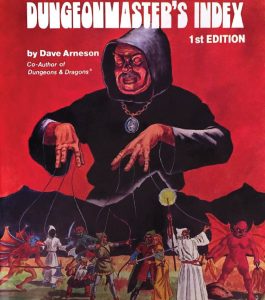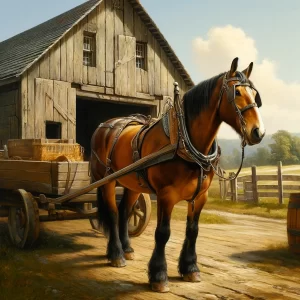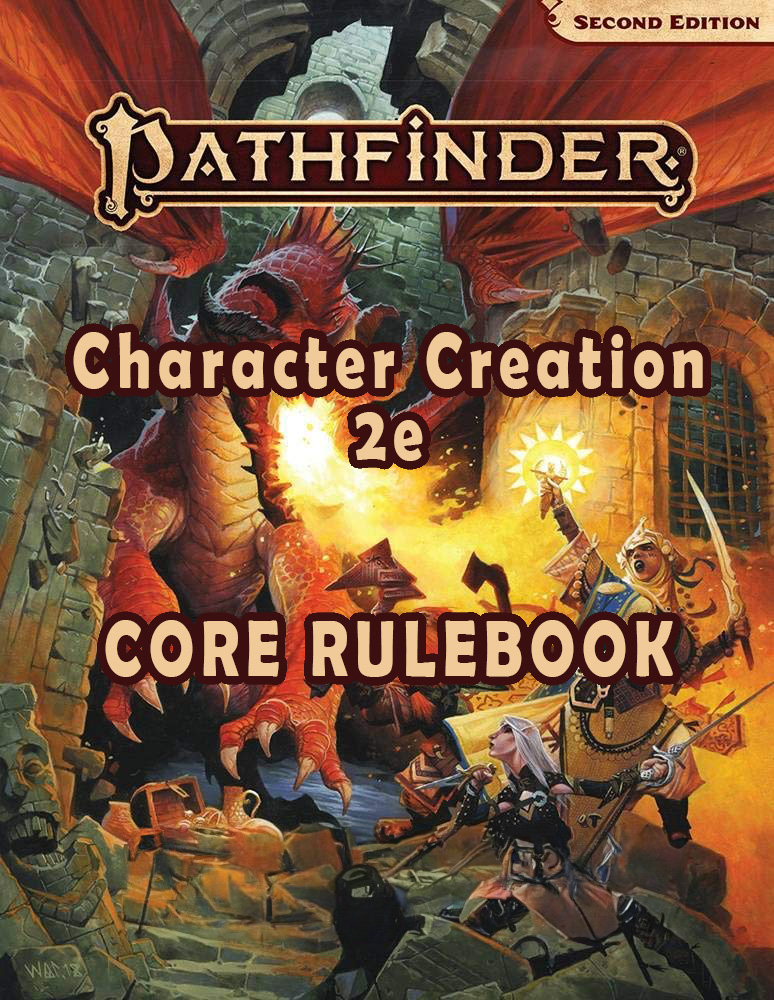
Pathfinder 2e PDF Character Sheet Download
Also can use Pathfinder 2e Character Generator
In the world of Pathfinder, the initial act for every would-be hero, except for the esteemed Game Master, is the creation of their character. This is where you breathe life into a persona, weaving together their history, personality, and outlook on the world. These intricately crafted facets become the cornerstone of your roleplaying experience. The game's mechanics are your palette, allowing you to paint your character's competencies in various endeavors and their mastery of extraordinary abilities.
Presented here is a comprehensive, step-by-step odyssey to character creation, illuminated by the guiding light of the Pathfinder rules. The journey commences with a deep dive into understanding ability scores. These scores are not mere numbers; they are the lifeblood of your character, influencing your choices at numerous junctures in the creation process. While the path of character creation is laid out in a recommended sequence, feel free to embark on this journey in any order that resonates with your vision.
Dotted throughout pages 21 to 28 are milestones, guiding you to populate the fields of your character sheet. This sheet, depicted on pages 24 and 25 and also accessible online, is your ledger of destiny. It's crafted for intuitive use during gameplay, yet character creation is a dance of steps, leading you to various points on the sheet. The sheet encompasses all possible elements you might require, though not every character will fill every field. Should a field not align with your character's narrative, simply let it remain untouched.
Every step on this path to creation is meticulously detailed in the subsequent pages, each marked with a number correlating to the sample character sheet. This ensures you know precisely where to inscribe each detail. For fields that reside in the unseen realms of the third or fourth page of the character sheet, the guiding text will be your beacon.
For those crafting a hero of higher caliber, embarking on this foundational journey is recommended before venturing to page 29, where the secrets of character advancement await.
In the realm of Pathfinder, the essence of your character is encapsulated in six pivotal Ability Scores. These scores are the bedrock of your character's innate potential, casting their influence across the expanse of your character sheet. The journey of determining these scores is not a singular event but unfolds gracefully through the various stages of character creation.
These scores are divided into two distinct realms: the physical and the mental. Strength, Dexterity, and Constitution form the triumvirate of physical scores, painting a picture of your character's muscular fortitude, agility, and endurance. In contrast, the mental triad of Intelligence, Wisdom, and Charisma illuminate your character's intellectual acumen, perceptual depth, and charismatic influence.
The mastery of each ability score is not just a number; it is a key unlocking a plethora of related skills and checks. As you craft your character's narrative, ponder which ability scores will be the cornerstones of their success.
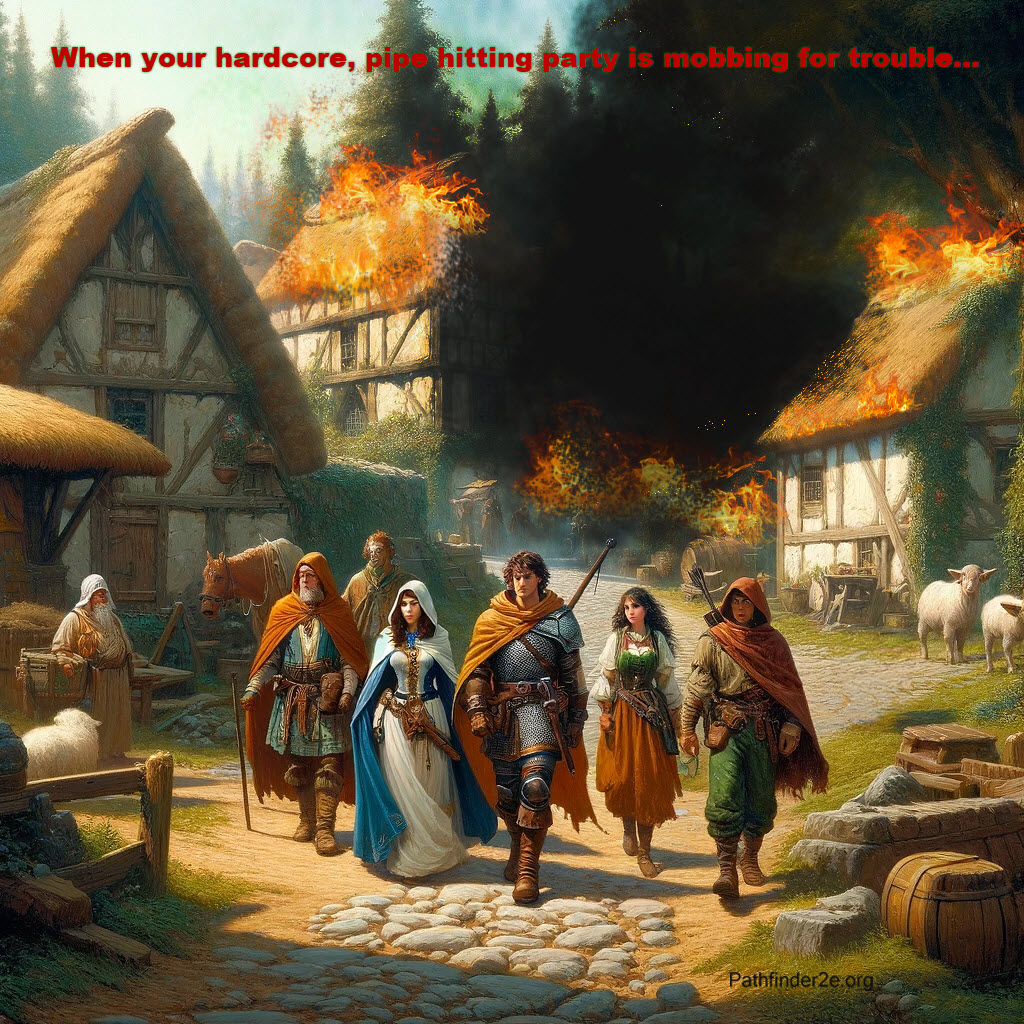
Strength: The very symbol of brawn and brute force. Essential for characters who delve into the thick of melee combat, strength not only bolsters your prowess in dealing damage but also dictates the burdens you can bear.
Dexterity: A reflection of your character's lithe agility, fine balance, and swift reflexes. Dexterity is crucial for those who favor ranged combat or the art of stealth. It also weaves into your character's armor class and reflexive instincts.
Constitution: The bastion of health and stamina. A robust constitution is vital for all, especially for those who brave the frontline of battle. It fortifies your hit points and fortitude, the very bulwarks against harm.
Intelligence: A measure of your character's capacity to learn, reason, and analyze. High intelligence is the wellspring of varied skills and linguistic prowess, opening doors to a plethora of knowledge and understanding.
Wisdom: The gauge of common sense, perception, and intuition. Wisdom influences your character's awareness and resilience, particularly in perception and mental fortitude.
Charisma: The essence of charm and influence. High charisma is the art of swaying minds and hearts, a tool for those who seek to lead, inspire, or deceive.
Each ability score is a thread in the rich tapestry of your character's identity, influencing how they interact with the world and the challenges it presents. As you embark on this journey of creation, consider how each score will shape your character's path to glory.
In Pathfinder's world, the journey of character creation is deeply intertwined with the concept of Ability Scores. These scores begin at a baseline of 10, representing the average human capability. As you weave the narrative of your character, these scores will fluctuate, molded by the choices you make throughout their creation.
Crafting Your Character's Essence: The Role of Ability Scores
- Ancestry: The roots of your character lie in their ancestry, each offering unique ability boosts and occasionally, a flaw. These ancestral traits are the first brushstrokes in defining your character's capabilities. Should you choose to embrace voluntary flaws for a richer backstory, this is the stage where they come into play. (Refer to the sidebar on page 24 for details).
- Background: The backdrop of your character's life story grants two additional ability boosts. These reflect the skills and strengths garnered through their life experiences before embarking on their adventure.
- Class: The class you select for your character imparts a significant ability boost, aligned with the core attribute of the chosen class, often referred to as the key ability score. This boost is a reflection of the specialized training or innate talents your character possesses in their chosen field.
- Determination of Scores: After laying the groundwork through ancestry, background, and class, you have the opportunity to further tailor your character by applying four additional ability boosts. These choices are yours to make, shaping your character's strengths to fit your vision. Following these adjustments, calculate the ability modifiers, which will play a pivotal role in your character's interactions and successes in the game world.
The Dynamics of Ability Boosts and Flaws
- Ability Boosts: Typically, an ability boost enhances a score by 2 points. However, there's a threshold: if a score is already at a formidable 18 or higher, the boost only adds 1 point. In the initial stages of creation, no ability score can exceed 18. The game's rules will guide you on whether a boost is specific to an ability or flexible. When multiple boosts are available simultaneously, they must each enhance a different score. For instance, dwarves inherently receive boosts to Constitution and Wisdom, along with an additional free boost that can be allocated to any other score.
- Ability Flaws: Contrary to boosts, flaws are less frequent but equally impactful. An ability flaw, often emerging from your character's ancestry, reduces the relevant score by 2. This element adds depth and complexity, challenging you to craft a character with both strengths and vulnerabilities.
As you sculpt your Pathfinder character, remember that each decision you make in adjusting these Ability Scores is not just a mechanical choice, but a stroke in painting the portrait of a unique individual, ready to embark on epic adventures.

Step 1 in Pathfinder 2e Character Creation
Step 1 of character creation in Pathfinder is an imaginative and pivotal process where you start shaping the essence of your hero. This step is all about conceptualizing who you want to bring to life in the game's world.
Developing Your Character's Concept
Imagine the type of hero you wish to embody. This could range from a straightforward archetype like a valiant warrior to a more nuanced character such as an elf child raised among humans, with loyalties to Sarenrae, the goddess of the sun. Reflect on your character's personality, backstory, and the motivations that drive them to embark on adventures. This is the stage where the seeds of your character's identity are sown.
Explore the vast array of ancestries, backgrounds, and classes offered in Pathfinder. The information on pages 22 and 23 will assist you in aligning your character concept with the game's fundamental rules. Reviewing these options can spark inspiration and guide you in selecting the elements that resonate with your envisioned character.
Interactive Elements: Ancestry, Background, and Class
Ancestry: Your character's ancestry lays the groundwork for their biological traits and cultural heritage. Pathfinder offers a rich selection of ancestries, each with unique characteristics and heritages, like a human with elven lineage or a dwarf from a specific clan.
Background: The background you choose provides a glimpse into your character's life before their adventuring days. It might reflect their upbringing, family occupation, or an early career. This choice helps in fleshing out your character's past and how it shapes their present.
Class: Your character's class is a crucial element that dictates their role in adventures. It defines their skill set, combat style, and special abilities. Whether you choose a classic fighter or a stealthy rogue, each class brings unique abilities to your character's arsenal.
Challenging Norms and Exploring Identity
Your character can be a means to explore various aspects of identity, culture, and personal beliefs. They could challenge traditional gender roles, represent diverse cultural identities, or even navigate the world with a disability. Your character's faith can also play a significant role, drawing them towards certain deities and philosophies. Pathfinder's pantheon, detailed on pages 437-440, offers a range of deities, each embodying different ideals and domains.
The First Step in a Collaborative Journey
Remember, Pathfinder is a collaborative game. Discussing your character's background and potential connections with other players' characters can enrich the gaming experience. This collaborative planning helps in creating a cohesive party dynamic and sets the stage for epic adventures.
Once you have a solid concept for your character, you're ready to proceed to the detailed character building in Step 2, where you start translating your concept into game mechanics.

In Pathfinder, aligning your character's development with your fellow players can greatly enhance your group dynamics. This collaboration might reveal shared histories or connections, like being kin or originating from the same village. Such commonalities can add a rich layer to your gameplay.
Discussing your characters' combat roles is also key. A balanced party might include damage dealers, damage absorbers, and healers for a well-rounded approach to challenges. However, remember Pathfinder's diversity in classes offers numerous ways to shape your character beyond these roles. Embrace this flexibility and creativity in your character creation.
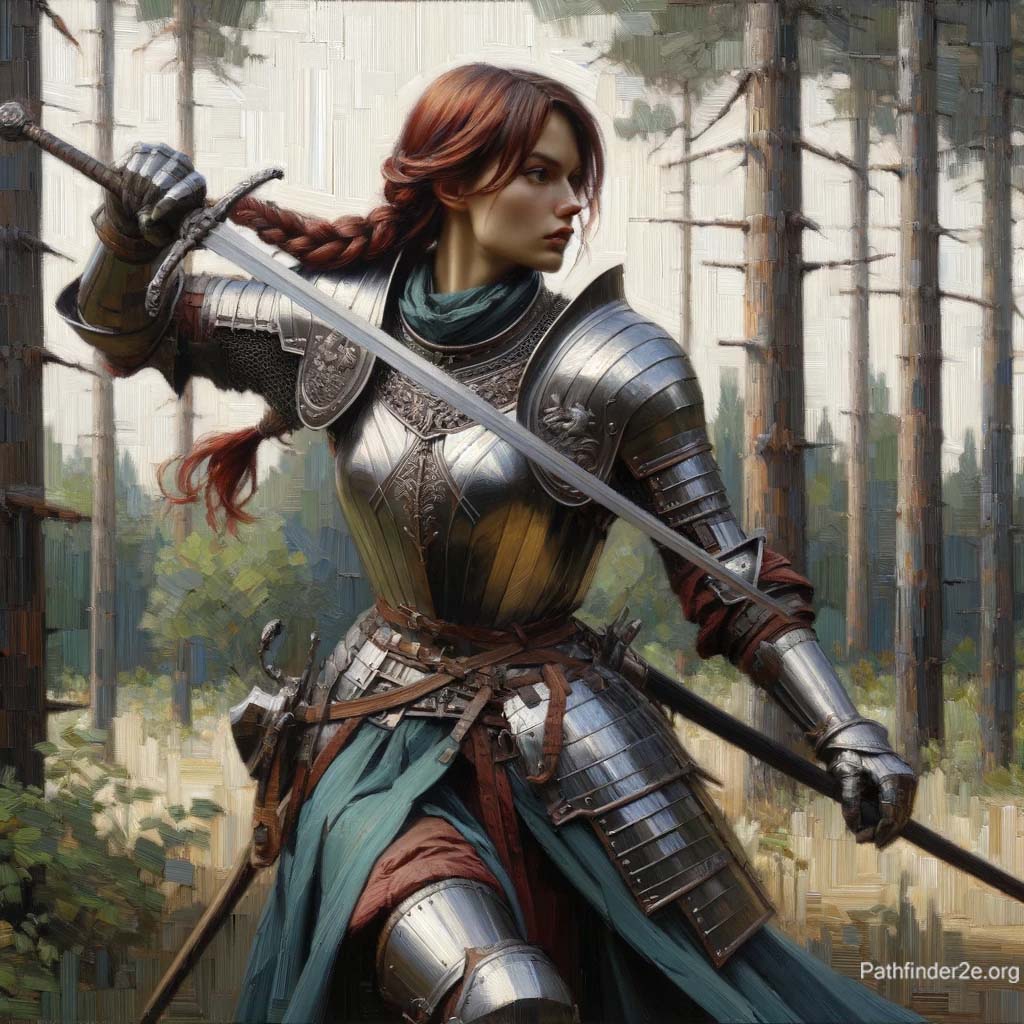
Step 2 in Pathfinder 2e Character Creation
Now you're at Step 2, where the foundational aspects of your Pathfinder character begin to take shape through their Ability Scores.
Crafting Your Character's Abilities
- Starting Point: Every ability score initially stands at 10, representing the average human capacity. This is your starting block for building your character's unique abilities.
- Incorporating Character Elements: As you choose your character's ancestry, background, and class, you'll modify these scores. Ability boosts (increasing a score by 2) and flaws (decreasing a score by 2) will come into play, reflecting the strengths and weaknesses inherent in your character's makeup.
- Recording Initial Scores: For now, mark a baseline of 10 in each ability score. This will be your reference point as you navigate through the character-building process.
- Understanding Boosts and Flaws: Make sure to acquaint yourself with the specific rules and nuances of applying ability boosts and flaws, detailed on page 20. This understanding is crucial as it significantly influences how your character will perform and interact in the game world.
- Focusing on Key Abilities: Refer back to the overview of The Six Ability Scores on page 19, and the class summaries on pages 22 - 23. This information will guide you in identifying which ability scores are most pivotal for your character's success, depending on their class and role in the party.
This step is a critical phase where you start turning the concept of your character into a playable entity within the Pathfinder universe. Enjoy the process of sculpting your character's abilities, keeping in mind how they will evolve and interact in the world you're about to explore.
Step 3 in Pathfinder 2e Character Creation
Step 3 in your Pathfinder character creation journey is selecting an ancestry, a crucial element that shapes many fundamental aspects of your character.
Choosing an Ancestry
- Review Ancestry Options: Refer to the summaries on page 22 for an overview of available ancestries. Each ancestry is elaborated in Chapter 2, providing detailed insights into their unique traits.
- Impact of Ancestry: Ancestry in Pathfinder goes beyond mere background flavor; it actively influences your character's physical attributes, such as size and speed, the languages they can speak, and even their base Hit Points.
- Ability Adjustments: Each ancestry comes with inherent ability boosts and potential flaws, reflecting their natural aptitudes and limitations. These will modify your character's ability scores established in Step 2.
Four Key Decisions in Ancestry Selection
a) Selecting the Ancestry: Choose which ancestry resonates with the character concept you have in mind. This choice should align with both the narrative and mechanical aspects of your character.
b) Ability Boosts and Flaws: Decide on any free ability boosts provided by the ancestry and consider if you want to take on any voluntary flaws. These decisions will further refine your character's ability scores.
c) Heritage Choice: Within your chosen ancestry, select a heritage. Heritages allow you to narrow down your character's background even further, offering specific traits inherited from their lineage.
d) Ancestry Feat: Choose an ancestry feat, representing a special skill or ability your character has learned from their cultural or familial background. This feat can provide a unique advantage or capability in your adventures.
By the end of this step, your character will have a rich background rooted in the world of Pathfinder, complete with specific traits that will influence their journey and interactions within the game. Remember, the choice of ancestry is more than a mechanical decision; it's the first chapter in your character's story.
After selecting your character's ancestry and heritage in Pathfinder, it's time to reflect these choices on your character sheet, the primary document that tracks your character's journey and growth.
Filling Out the Character Sheet: Ancestry and Heritage Details
- Ancestry and Heritage: At the top of the first page of your character sheet, clearly write down your character's chosen ancestry and heritage. This serves as a quick reference to the fundamental aspects of your character's identity.
- Adjusting Ability Scores: Based on the ability boosts and flaws associated with your chosen ancestry, adjust your character's ability scores. Add 2 points to a score for each ability boost and subtract 2 points for any flaw. These adjustments are pivotal as they begin to shape your character's strengths and weaknesses.
- Recording Hit Points: Ancestries contribute to your character's initial Hit Points. Note down the Hit Points provided by your ancestry in the designated area. These points form the base of your character's health, which will increase as you progress in the game.
- Character's Physical Traits: In the relevant sections of the sheet, record your character's size, Speed, and the languages they can speak. These traits are directly influenced by the chosen ancestry and are crucial for interactions and movements in the game.
- Special Abilities: If your ancestry grants any special abilities (like darkvision, unique sensory abilities, or other innate talents), make sure to note these in the appropriate sections, usually under 'Senses' or a similar area. These abilities can provide significant advantages in various scenarios during your adventures.
By meticulously updating your character sheet with these details, you create a comprehensive and accessible record of who your character is and what they are capable of, setting the stage for the adventures ahead. This process not only helps in keeping track of your character's development but also aids in immersing yourself in the role-playing experience.

Step 4 in Pathfinder 2e Character Creation
Step 4 in the Pathfinder character creation process involves choosing a background, which is essential in adding depth and context to your character's life before their adventuring days began.
Selecting a Background
- Background Significance: Your character's background can reflect various elements of their early life, such as upbringing, innate talents, or significant life events that occurred before they started adventuring. This choice provides a narrative foundation and influences their abilities and skills.
- Finding Backgrounds: Detailed descriptions of various backgrounds are available in Chapter 2, starting on page 60. Here, you'll find a range of backgrounds to choose from, each bringing its unique flavor to your character's story.
- Benefits of a Background: When you select a background, it typically grants your character two ability boosts. One boost is usually flexible, applicable to one of two specific ability scores related to the background, and the other is a free boost that can be applied to any ability score. This flexibility allows you to tailor your character's strengths in a way that aligns with their backstory.
- Skill Proficiencies and Feat: Additionally, a background provides training in a specific skill and a Lore skill, which represents specialized knowledge your character has acquired. Moreover, each background includes a skill feat, giving your character a unique capability or advantage in certain situations.
By carefully choosing a background, you not only enhance your character's abilities but also enrich their personal narrative, giving more depth to who they are and how they interact with the Pathfinder world. This step is crucial in shaping a well-rounded character with a past that informs their present and future adventures.
Step 5 in Pathfinder 2e Character Creation
Step 5 in Pathfinder's character creation is a significant one: choosing your character's class. This decision shapes the core of your character's capabilities and role within the game.
Deciding on a Class
- Role and Abilities: The class you choose defines the range of heroic abilities your character will have, influencing their combat style and effectiveness. It also affects how your character handles various challenges and dangers they might encounter.
- Class Details: For a comprehensive understanding of each class, refer to Chapter 3, where every class is detailed extensively. However, for a quick overview, including which ability scores are pivotal for each class, pages 22-23 provide concise summaries. These summaries are valuable for aligning your class choice with the strengths you've built up in your character's ability scores.
- Initial Focus: At this stage, you don't need to record every feature and ability of the class. Your primary task is to select the class that best fits your vision for your character. The class you choose will guide you in determining which ability scores will be crucial for your character, based on the class's key skills and abilities.
Selecting a class is more than just picking a set of skills; it's about defining the very essence of your character's journey, their approach to challenges, and their role in the adventuring party. Take your time to consider how each class aligns with your character's backstory and future aspirations in the Pathfinder world.
Step 6 in Pathfinder 2e Character Creation
Step 6 in Pathfinder character creation is crucial as it finalizes the ability scores that form the bedrock of your character's capabilities.
Finalizing Ability Scores
- Review and Apply Previous Choices: Revisit the ability boosts and flaws you've chosen based on your character's ancestry, background, and class. Ensure that these have been accurately applied to the relevant ability scores.
- Additional Ability Boosts: Now, you get to enhance your character further by applying four more ability boosts. Each of these boosts should increase a different ability score by 2 points. This step allows you to further tailor your character's strengths.
- Record Final Scores and Modifiers: After applying all boosts and flaws, note down the final ability scores on your character sheet. Use the Ability Modifiers table (Table 1-1) to calculate and record the corresponding modifiers for each ability score.
Voluntary Flaws
- Adding Depth with Flaws: For a more nuanced and potentially challenging character, consider taking voluntary flaws. This option lets you roleplay a character with significant weaknesses, adding depth and complexity.
- Consultation with Group: If you decide to introduce a voluntary flaw, it's advisable to discuss this with your gaming group to ensure it aligns with the game's tone and group dynamics.
- Limitations: Remember, you can't assign more than one flaw to a single ability score, and the final ability scores should not drop below 8 or exceed 18 after all adjustments.
Updating the Character Sheet
- Ability Scores: In the designated boxes on your character sheet, write down the final ability scores for each ability.
- Modifiers: Next to each ability score, record the appropriate ability modifier, which is a crucial number used in many of the game's mechanics.
This step is the culmination of the mechanical aspect of your character's creation, providing a clear picture of their inherent strengths and weaknesses as they prepare to embark on their adventures in the Pathfinder world.
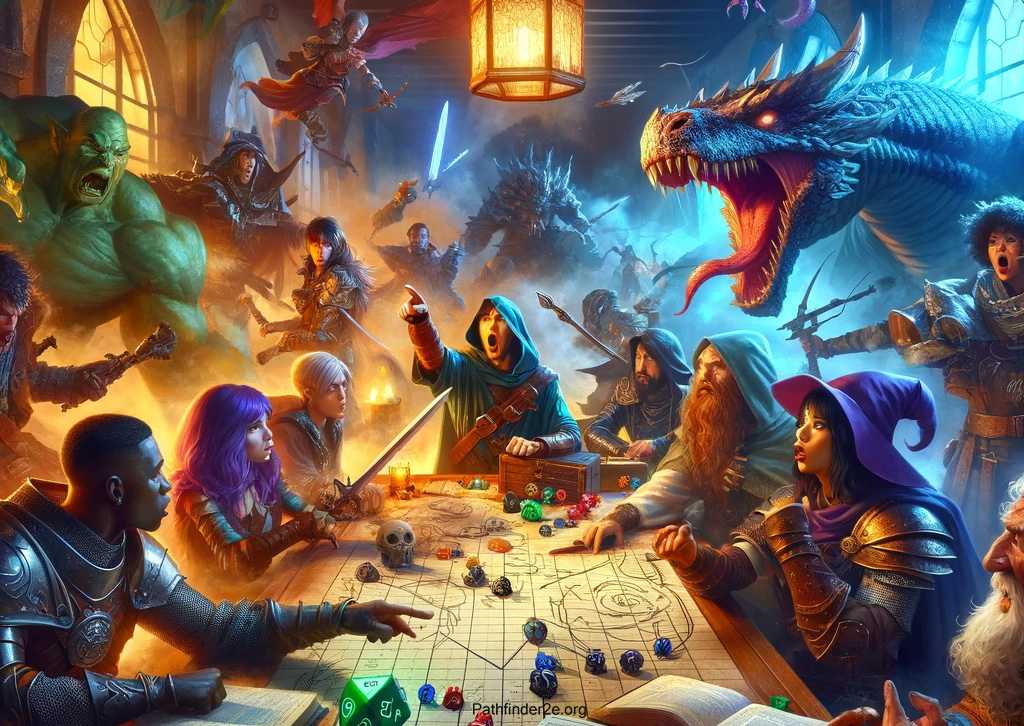
Step 7 in Pathfinder 2e Character Creation
In Step 7 of Pathfinder character creation, you delve into the specific class features and abilities that your character will possess. This step is crucial in fleshing out how your character functions and what they can do in the game.
Recording Class Features and Benefits
- Detailing Class Benefits: On your character sheet, start by documenting all the benefits and features that your chosen class provides. This includes any special abilities, inherent skills, or unique traits that come with the class.
- Spellcasting Classes: If your character belongs to a class with spellcasting abilities (like a bard, cleric, druid, sorcerer, or wizard), this step involves understanding and noting down the spells they can cast. Use the fourth page of the character sheet to record your character's magic tradition, proficiency in spell attack rolls and spell DCs, and the spells they know or prepare.
- Calculating Total Hit Points: Add the Hit Points your character receives from their ancestry to those they gain from their class. This total represents your character's starting health pool. Record this total on the first page of your character sheet.
- Initial Proficiencies: Consult the class entry to determine your character's starting proficiencies in various skills and record these on your character sheet. If your character is already trained in a skill due to their background, you may choose another skill to be trained in.
- Class Advancement Table: Refer to the class advancement table in your class entry to understand what features and abilities your character gets at 1st level. Some of these features might require you to make additional choices, like selecting specific spells.
Updating the Character Sheet
- Total Hit Points: Write down your character's total Hit Points at the top of the first page.
- Proficiencies: In the proficiency fields (marked "T" for trained, "E" for expert, "M" for master, and "L" for legendary), record your character's initial proficiencies in skills, Perception, saving throws, and any other areas as indicated by their class.
- Skills and Weapon Proficiencies: Mark the proficiency level for each skill your character is trained in. Also, record any armor and weapon proficiencies in the respective sections.
- Class Feats and Abilities: On the second page of your character sheet, list all the class feats and abilities your character has at 1st level.
Remember, at this stage, you don't need to finalize every statistic for your character. This will be done in a later step. For now, focus on getting a clear picture of your character's core abilities and skills as determined by their class.
Step 8 in Pathfinder 2e Character Creation
Step 8 in the Pathfinder character creation process involves equipping your character with the necessary gear for their upcoming adventures. At this stage, your character starts with a budget to spend on various items essential for survival and combat.
Allocating Your Starting Funds
- Starting Budget: Your character begins with 15 gold pieces (equivalent to 150 silver pieces). This is your budget for purchasing initial equipment.
- Choosing Weapons and Armor: Refer to your character's class description to understand which types of weapons and armor they are proficient in. Selecting the right equipment is crucial, as it affects your character's effectiveness in combat. Weapons determine your damage output, while armor contributes to your Armor Class, a key defense mechanism in the game.
- Covering the Basics: Beyond weapons and armor, consider purchasing essential items like food, traveling gear, and other adventuring essentials. These items are often vital for survival and successful navigation of the game world.
- Consulting Equipment Lists: For a detailed list of available equipment, along with their costs, refer to Chapter 6. This chapter provides a comprehensive guide to the items you can buy, helping you make informed decisions about how to allocate your funds.
Strategic Purchasing
- Balancing Needs: As you decide on your purchases, balance your spending between offensive and defensive capabilities and basic survival needs. The choices you make here can significantly impact your character's initial experiences in the game.
- Character Class Considerations: Keep in mind your character's class when selecting equipment. Certain classes might benefit more from specific types of weapons or armor. Additionally, your class might grant you proficiency in certain equipment, optimizing your effectiveness with those items.
This step is about preparing your character for the practical aspects of adventuring. It's not just about arming them for battle but also ensuring they have the necessary supplies to endure the challenges of a life filled with adventure. Make your choices wisely to set your character up for success.

Step 9 in Pathfinder 2e Character Creation
Step 9 in Pathfinder character creation is about calculating and recording various modifiers that will be essential in gameplay. These modifiers play a crucial role in determining how effective your character is in various situations, from combat to skill checks.
Calculating Modifiers
- Proficiency Bonus: Your proficiency bonus is determined by your character's proficiency rank in a given statistic (trained, expert, master, or legendary). It's calculated as your character's level plus a number based on the rank (2 for trained, 4 for expert, 6 for master, and 8 for legendary). If untrained, the bonus is +0.
- Perception Modifier: Calculate your Perception modifier, which is the sum of your proficiency bonus in Perception and your Wisdom modifier. This reflects how alert and aware your character is.
- Saving Throws: For each type of saving throw (Fortitude, Reflex, Will), add the relevant proficiency bonus to the appropriate ability modifier:
- Fortitude: Constitution modifier
- Reflex: Dexterity modifier
- Will: Wisdom modifier
Include any constant bonuses or penalties from abilities, feats, or items.
- Melee and Ranged Strikes: For each weapon, calculate the Strike modifier, which is your proficiency bonus with that weapon type plus the relevant ability modifier (Strength for melee, Dexterity for ranged). Also, calculate the damage each weapon deals, usually adding your Strength modifier for melee weapons.
- Skills: For each skill in which your character is trained, add your proficiency bonus for that skill to the ability score modifier linked to that skill. Record the total modifier for each skill. For untrained skills, the total modifier is just the ability score modifier.
Updating the Character Sheet
- Perception and Saving Throws: Write down the proficiency bonus and ability modifier for Perception and each saving throw, then record the total modifier.
- Weapon Statistics: Next to each listed weapon, write the proficiency bonus, ability modifier, and total modifier for Strikes. Below this, note the damage each weapon deals, including any relevant traits.
- Skill Modifiers: In the skill section, record the relevant ability modifier and proficiency bonus for each skill, then write the total skill modifier.
- Additional Modifiers: If there are any other modifiers, bonuses, or penalties that always apply (from feats, abilities, etc.), include them in the total modifiers. Note situational modifiers alongside the total modifiers.
This step finalizes the mechanical aspects of your character, setting them up with the necessary statistics for various actions and challenges they will encounter in the game. With these modifiers in place, your character is now ready for the dynamic world of Pathfinder.
Step 10 in Pathfinder 2e Character Creation
In Step 10 of Pathfinder character creation, you'll be adding the finishing details to your character sheet, fleshing out important aspects of your character's identity, abilities, and mechanics.
Adding Finishing Details to Your Character Sheet
- Alignment: Define your character's moral and ethical compass by selecting an alignment from the nine available options. This decision will influence how various game elements interact with your character. Remember, alignment can change based on your character's actions and decisions throughout the game.
- Deity: If applicable, choose and note down the deity your character worships. This is particularly important for classes like champions and clerics, whose powers and abilities are closely tied to their deity.
- Age: Determine and record your character's age. This can be based on the typical age ranges for their ancestry, but feel free to choose any age that fits your character concept.
- Gender and Pronouns: State your character's gender and pronouns, contributing to their personal identity and how they are perceived in the game world.
- Class Difficulty Class (DC): Calculate and note your character's Class DC. It's determined by adding 10 to their proficiency bonus for their class DC, plus the modifier for the class's key ability score.
- Hero Points: Your character starts with 1 Hero Point, a mechanic used for crucial rerolls or avoiding death. Be sure to understand and track Hero Points during gameplay.
- Armor Class (AC): Calculate your character's AC, which is crucial in combat. It includes their Dexterity modifier, proficiency with armor, the armor's item bonus, and other relevant modifiers.
- Bulk: Understand and record your character's carrying capacity or Bulk. This affects how much they can carry without being encumbered and is based on their Strength score.
- Equipment and Weapons: Finalize and record any remaining details about your character's equipment, weapons, and armor, including the calculation of attack bonuses, AC, and carrying capacity (Bulk).
These finishing touches are essential in bringing your character to life in the Pathfinder world. They add depth to your character's personality and background, while also setting the mechanical groundwork for their capabilities and limitations in various situations throughout the game. With these details in place, your character is now fully fleshed out and ready for adventure.



